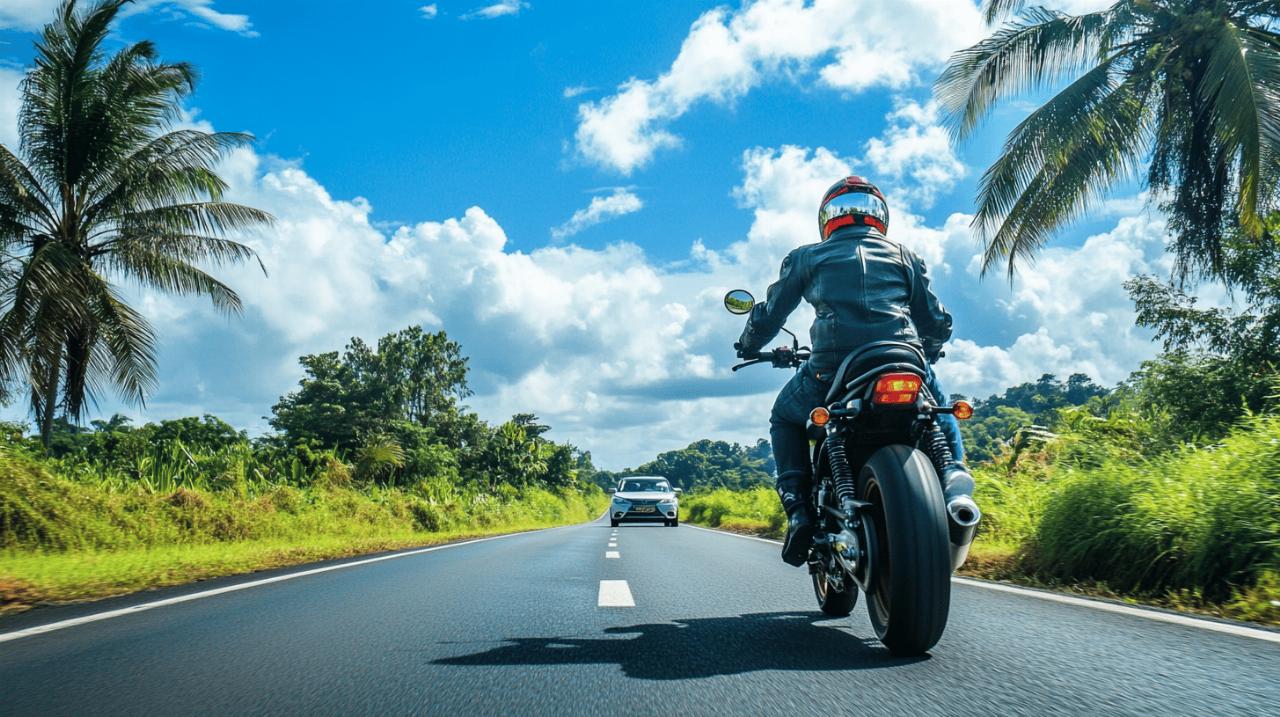Navigating British roads on a motorcycle presents unique challenges and opportunities, particularly when it comes to overtaking slower vehicles. Understanding the legal framework, mastering essential techniques, and ensuring proper training and insurance coverage are all critical components of safe and confident riding. This comprehensive guide explores everything motorcyclists in the UK need to know about overtaking cars legally and safely, from Highway Code requirements to advanced riding skills.
Understanding uk motorcycle overtaking laws and highway code requirements
Legal Framework for Motorcycle Overtaking in Britain
The legal landscape governing motorcycle overtaking in Britain is established through the Highway Code and various Department for Transport regulations. Overtaking is fundamentally defined as passing another vehicle that is travelling in the same direction as you, and whilst it remains a common and necessary manoeuvre, it must only be undertaken when it is safe, legal, and genuinely necessary. Breaking these rules can result in serious consequences, including fines that may reach two thousand five hundred pounds, six penalty points on your driving licence, or even motorcycle seizure in severe cases. The law explicitly prohibits overtaking where road signs forbid it or where the manoeuvre would be considered dangerous. Crucially, motorcyclists must never exceed the speed limit whilst overtaking, even if the vehicle ahead is travelling below the posted limit. Speed limits across Britain vary depending on road type, typically thirty miles per hour in built-up areas, sixty miles per hour on single carriageways, and seventy miles per hour on dual carriageways and motorways. Violating these limits during an overtaking manoeuvre compounds the offence and demonstrates a disregard for road safety that authorities take extremely seriously.
Highway code rules specific to motorcyclists when passing other vehicles
The Highway Code contains specific guidance for motorcyclists that goes beyond general overtaking rules. Rule eighty-eight emphasises the importance of checking your surroundings thoroughly before any manoeuvring, maintaining awareness of pedestrians and other vehicles, and keeping speed low when filtering through traffic. Filtering, which involves manoeuvring through stationary or slow-moving traffic, is legal in the UK and commonly practised in congested areas, though it requires heightened awareness and excellent judgement. When filtering, experienced riders suggest maintaining a speed difference of no more than ten to fifteen miles per hour compared to surrounding traffic, though this serves as guidance rather than a strict legal requirement. Rule eighty-six stresses the importance of visibility, recommending that motorcyclists wear bright clothing and use dipped headlights even during daylight hours to make themselves conspicuous to other road users. Reflective clothing becomes particularly important at night, as outlined in Rule eighty-seven. Road markings play a crucial role in determining where overtaking is permitted. Double solid white lines categorically forbid overtaking, and violating this restriction can lead to prosecution. Understanding these markings and respecting them is fundamental to legal riding in Britain.
Essential Safety Techniques for Overtaking Cars on Your Motorcycle
Assessing road conditions and visibility before making your move
Before initiating any overtaking manoeuvre, a thorough assessment of road conditions and visibility is absolutely essential. Experienced riders advocate a methodical approach that considers whether the overtake is genuinely necessary, whether road signs permit it, whether there are any hazards ahead, and whether visibility is sufficient to complete the manoeuvre safely. A clear view of approximately one hundred metres ahead is generally considered the minimum safe distance required to overtake and return to your lane without cutting up the vehicle you have just passed. Weather conditions significantly impact the wisdom of attempting an overtake. Poor weather, including rain, fog, or strong winds, reduces visibility and traction, making overtaking considerably more hazardous. Similarly, overtaking should be avoided near junctions, lay-bys, or areas where pedestrians might unexpectedly enter the roadway. Motorcyclists must also be acutely aware that car drivers may be distracted or impatient, potentially making sudden movements without adequate warning. This unpredictability necessitates a defensive riding approach that anticipates potential hazards and maintains escape routes throughout the manoeuvre. The IPSGA system, which stands for Information, Position, Speed, Gear, and Acceleration, provides a structured framework for planning and executing safe overtakes. This system ensures that riders gather all necessary information about the road ahead, position themselves optimally, adjust their speed appropriately, select the correct gear for rapid acceleration, and then complete the overtake with confidence. The motorcycling community often repeats the maxim that if you find yourself in doubt about whether an overtake is safe, the correct decision is always to abandon the attempt and wait for a better opportunity.
Proper signalling, positioning and acceleration during overtaking manoeuvres
Executing the overtaking manoeuvre itself requires precise coordination of several actions. Before moving out, motorcyclists must check their mirrors thoroughly to ensure no faster vehicle is approaching from behind, as motorcycles themselves can be overtaken by other motorcycles or vehicles. Once you have confirmed the road ahead and behind is clear, drop back slightly from the vehicle you intend to pass to improve your view and give yourself space to build momentum. Signal your intention clearly and early, ensuring other road users understand your plan. Acceleration should be confident and smooth, allowing you to pass the slower vehicle swiftly without lingering alongside it longer than necessary. Throughout the manoeuvre, maintain awareness of your position relative to oncoming traffic and be prepared to abort if conditions change. Once past the vehicle, signal again before returning to your lane, and ensure you leave adequate space before moving back in. Cutting up the driver you have just overtaken is not only discourteous but can also create dangerous situations if they need to brake suddenly. When considering overtaking multiple vehicles, the same principles apply but with added complexity. Only attempt to pass several cars if you have a substantially clear and long stretch of road, excellent visibility, and complete confidence in your ability to complete the manoeuvre without forcing any other road user to take evasive action. Special consideration must be given when overtaking vulnerable road users such as cyclists and horse riders. The Highway Code advises giving these road users plenty of room, reducing speed significantly, and passing slowly and carefully to avoid startling animals or causing cyclists to lose balance.
Motorcycle Licence Categories and Training for Safe Overtaking
CBT, A1, A2 and Full A Licence Requirements for Overtaking Competency
 The UK operates a tiered motorcycle licensing system designed to ensure riders develop competency progressively based on age, experience, and demonstrated ability. Understanding these licence categories is essential because the training and testing requirements at each level include assessment of overtaking skills. Compulsory Basic Training, commonly known as CBT, represents the entry point for most new riders. This one-day course covers fundamental skills including an introduction to motorcycling, on-site safety training, a road safety discussion, and at least two hours of supervised on-road riding. Upon completion, riders receive a DL196 certificate valid for two years, which permits them to ride motorcycles up to one hundred and twenty-five cubic centimetres with L plates displayed. However, CBT holders face significant restrictions, including a prohibition on carrying pillion passengers and riding on motorways, limitations that also restrict their opportunities to practise overtaking in faster-moving traffic conditions. The AM licence, available from age sixteen, allows riding of mopeds and scooters up to fifty cubic centimetres with a maximum speed of twenty-eight miles per hour. The A1 licence, accessible from age seventeen, permits light motorcycles up to one hundred and twenty-five cubic centimetres and eleven kilowatts of power. At age nineteen, riders can progress to the A2 licence, which allows motorcycles up to thirty-five kilowatts. The unrestricted A licence permits riding any motorcycle regardless of engine size or power output. Two routes exist to obtain this full licence: the Direct Access Scheme for those aged twenty-four or older, which allows progression directly from CBT to the full A licence, and Progressive Access for those who have held an A2 licence for at least two years and are at least twenty-one years old. Each progression through these licence categories involves practical testing that assesses overtaking ability and judgement.
The UK operates a tiered motorcycle licensing system designed to ensure riders develop competency progressively based on age, experience, and demonstrated ability. Understanding these licence categories is essential because the training and testing requirements at each level include assessment of overtaking skills. Compulsory Basic Training, commonly known as CBT, represents the entry point for most new riders. This one-day course covers fundamental skills including an introduction to motorcycling, on-site safety training, a road safety discussion, and at least two hours of supervised on-road riding. Upon completion, riders receive a DL196 certificate valid for two years, which permits them to ride motorcycles up to one hundred and twenty-five cubic centimetres with L plates displayed. However, CBT holders face significant restrictions, including a prohibition on carrying pillion passengers and riding on motorways, limitations that also restrict their opportunities to practise overtaking in faster-moving traffic conditions. The AM licence, available from age sixteen, allows riding of mopeds and scooters up to fifty cubic centimetres with a maximum speed of twenty-eight miles per hour. The A1 licence, accessible from age seventeen, permits light motorcycles up to one hundred and twenty-five cubic centimetres and eleven kilowatts of power. At age nineteen, riders can progress to the A2 licence, which allows motorcycles up to thirty-five kilowatts. The unrestricted A licence permits riding any motorcycle regardless of engine size or power output. Two routes exist to obtain this full licence: the Direct Access Scheme for those aged twenty-four or older, which allows progression directly from CBT to the full A licence, and Progressive Access for those who have held an A2 licence for at least two years and are at least twenty-one years old. Each progression through these licence categories involves practical testing that assesses overtaking ability and judgement.
Advanced riding courses to enhance your overtaking skills
Beyond the statutory licensing requirements, numerous advanced riding courses are available throughout Britain to help motorcyclists refine their overtaking skills and overall road safety awareness. These courses, offered by organisations such as Phoenix Motorcycle Training and similar providers, include options like Module One courses focusing on slow control and manoeuvring, Module Two courses emphasising on-road skills, and dedicated Advanced Courses that explore complex scenarios including challenging overtaking situations. Slow Control Courses specifically help riders develop the fine throttle and clutch control necessary for filtering through congested traffic, a skill closely related to overtaking. Motorcycle Instructor Training programmes provide the highest level of riding education, equipping participants with both advanced personal skills and the ability to teach others. Many advanced courses utilise the IPSGA system intensively, drilling riders in its application until it becomes second nature. Online platforms such as Motorcycle Riders Hub complement practical training by providing theoretical knowledge and scenario-based learning that can be reviewed repeatedly. Investing in advanced training demonstrates a commitment to road safety and responsible riding that can also benefit motorcyclists financially, as many insurance providers offer premium discounts to riders who have completed recognised advanced courses. These courses emphasise not just technical skill but also the development of a patient and responsible attitude, recognising that aggressive behaviour and unnecessary challenges for road space significantly increase accident risk.
Insurance considerations and financial protection when overtaking
How overtaking incidents affect your motorcycle insurance premiums
Motorcycle insurance represents a legal requirement in Britain, with riding without valid cover resulting in fines exceeding three hundred pounds, six penalty points, and potential motorcycle seizure. The manner in which you overtake and your involvement in any incidents during overtaking manoeuvres can have substantial impacts on your insurance premiums and coverage. Insurance providers assess risk based on multiple factors including your licence type, riding experience, claims history, and any penalty points accumulated. An accident occurring during an overtaking manoeuvre, particularly if you are found at fault, will likely result in significantly increased premiums at renewal. If the accident results from illegal overtaking, such as crossing solid white lines or exceeding speed limits, insurers may dispute liability coverage, potentially leaving you personally liable for damages and injuries. Conversely, maintaining a clean riding record with no claims or convictions demonstrates responsible riding behaviour and can lead to substantial premium reductions over time through accumulation of no-claims bonuses. Some insurers offer specific discounts for riders who have completed advanced training courses, recognising that educated riders pose lower risks. Younger riders and those holding provisional licences or CBT certificates typically face higher premiums due to statistical evidence showing increased accident rates among these groups. Progressive movement through the licensing tiers from A1 through A2 to full A licence status generally corresponds with decreasing insurance costs, reflecting both increased experience and the completion of additional testing.
Legal Cover and Financial Safeguards for Motorcyclists in Britain
Beyond basic insurance coverage, motorcyclists should consider additional financial protections that become particularly relevant in the context of overtaking incidents. Legal expenses insurance provides funding for legal representation if you are involved in an accident where liability is disputed. Given that overtaking manoeuvres can result in complex liability questions, particularly in incidents involving multiple vehicles, having access to legal expertise can prove invaluable. This coverage typically costs relatively little when added to a standard motorcycle insurance policy but can provide protection worth thousands of pounds if legal proceedings become necessary. Personal injury protection and income protection insurance provide financial security if you are injured during an overtaking incident and unable to work. Motorcycle accidents statistically result in more serious injuries than car accidents due to the exposed nature of riding, making these coverages particularly relevant for motorcyclists. If you are involved in an accident whilst overtaking, the law requires you to stop immediately, exchange details with other parties involved, and report the incident to police if injuries have occurred or if you cannot exchange details at the scene. Failure to comply with these requirements constitutes an offence that can result in prosecution regardless of who was at fault for the original incident. Maintaining comprehensive records, including photographs of the scene, witness statements, and detailed notes about road and weather conditions, can prove crucial if insurance claims or legal proceedings follow. The financial implications of overtaking extend beyond insurance to include potential fines and penalties for violations. As mentioned earlier, speeding whilst overtaking can result in fines up to two thousand five hundred pounds and six penalty points, whilst dangerous overtaking can lead to more severe penalties including driving bans and imprisonment in cases involving serious injuries or fatalities. Understanding these financial and legal dimensions reinforces the importance of approaching every overtaking decision with careful consideration and prioritising safety above convenience or impatience.





